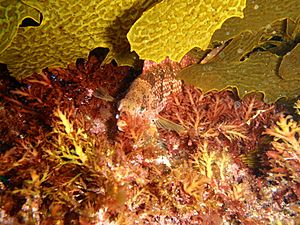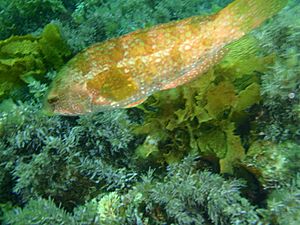Brownspotted wrasse facts for kids
Quick facts for kids Brownspotted wrasse |
|
|---|---|
 |
|
| female | |
 |
|
| male | |
| Conservation status | |
| Scientific classification | |
| Synonyms | |
|
The brownspotted wrasse (Notolabrus parilus) is a cool type of fish. People also call it the blue-spotted parrotfish or orangespotted wrasse. It's a ray-finned fish, which means its fins are supported by bony rays. This fish belongs to the wrasse family, called Labridae. You can find it in the Indian Ocean, swimming along the western and southern coasts of Australia.
Contents
What Does the Brownspotted Wrasse Look Like?
The brownspotted wrasse is a fairly big wrasse. It can grow up to about 31.2 centimeters (12.3 inches) long. That's about the length of a school ruler!
Male and Female Differences
Male brownspotted wrasse fish have a dark brown or grayish-brown color. They often have a broken white stripe along their body. Their scales might also show gold or brown patterns.
Female and young wrasse fish look a bit different. They are usually a lighter brown or even greenish. They have white spots on their scales. You might also see gray and brown stripes across their bodies.
Where Do Brownspotted Wrasse Live?
You can find the brownspotted wrasse along the coast of Australia. Their home stretches from Shark Bay in Western Australia. They swim all the way around the southern coast. Their range ends near southern Victoria.
Population Hotspots
These fish are most common off the coast of Western Australia. Especially around the southwestern part of the state. They are not as common in South Australia. In Victoria, they are quite rare, as that's the very edge of their living area.
Brownspotted Wrasse Habitat and Habits
The brownspotted wrasse likes to live near rocky reefs. These reefs often have lots of seaweeds growing on them. They prefer places that are calm or only a little bit wavy.
Depth and Young Fish
You can usually find them in water from 1 to 20 meters (3 to 65 feet) deep. But sometimes, they are seen in even deeper water. Young wrasse fish sometimes hang out in beds of sea grass.
What Do They Eat?
These wrasse are carnivores, which means they eat other animals. They hunt for small creatures that live on the seafloor. These creatures are called benthic invertebrates. They find their food in sandy areas, among sea grass, and in seaweeds.
Their diet includes many different things:
- Snails (gastropods)
- Small crustaceans like amphipods and isopods
- Prawns
- Crabs
- Sea urchins (echinoids)
How They Reproduce
The brownspotted wrasse has a special way of reproducing. They are protogynous hermaphrodites. This means they start their lives as females. Later, they can change into males! This change usually happens when the fish is about 17.5 to 20 centimeters (6.9 to 7.9 inches) long.
They lay their eggs, a process called spawning, in the late Australian winter to early spring. The eggs are laid among sea grass and reef areas. Both the eggs and the newly hatched larvae float freely in the open water. This open water zone is called the pelagic zone.
Naming the Brownspotted Wrasse
The brownspotted wrasse was first officially described in 1850. A Scottish naturalist named John Richardson gave it the scientific name Tautoga parila.
Where the Name Comes From
Richardson found this fish near King George Sound in Western Australia. The name parila was given to this fish by the Aboriginal people living in that area.
See also
 In Spanish: Notolabrus parilus para niños
In Spanish: Notolabrus parilus para niños


